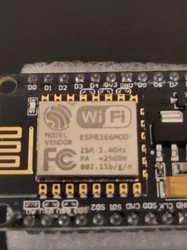- cross-posted to:
- piracy@lemmy.dbzer0.com
- cross-posted to:
- piracy@lemmy.dbzer0.com
Google getting rid of all the things that made people want an android phone over an iPhone.
Yep, if this happens there is no benefit to android.
I mean, there is still UI/UX, app store policies, and general cost/options.
This definitely makes Android a lot less appealing. But it is also questionable to act like the biggest reason to use android was sideloading apps since the vast majority of users don’t even know that is an option (and probably shouldn’t since they have no understanding of how to vet them). Especially since Apple isn’t any better (?).
Comrade, the ignorance of the masses should not dilute our anger
So… “the ignorance of the masses” should be combatted by willful ignorance and nonsense that falls apart the moment anyone looks at it?
Get angry. I sure am. Look for alternatives. Graphene sure ain’t it but I hope it will be in the next four or five years. But this is something google are willing to futz with for a reason: The vast majority of users don’t care about it and even with the changes it isn’t significantly worse than the competition.
Yet everywhere I see “Well, I guess I have to buy Apple now” which is just… buy it if you want to but don’t pretend this shit is why.
Ui/ux is honestly worse on android compared to something like ios. The playstore is honestly stuffed with ads and seems to be actively regressing in ux (the update apps menu is hidden behind like 3 layers of dialogues). Cost wise a used iPhone is probably a better deal than a cheap new android phone.
I used android primarily because I could install apps Apple basically doesn’t care about (and after the 5th time gba4ios broke).
Maybe it’s because I’m used to android, but iOS feels user hostile in ways that android never has been, especially when it comes to storage management and pushing iCloud subscriptions.
Well android phones dont have removable sd card slots anymore, the only way to transfer files is over the weird protocol that’s slower than directly writing to disk, if you use pixel or Samsung youre already inundated with annoying ads. The ecosystem is pretty awful now. Installing a custom rom is a good idea, but depending youre phone model it could be a step down and if your on any Samsung phone with knox it basically irreparably damages some attestation fuse. Apple ain’t much better. I might try a Linux phone next.
There is a lot wrong with android, but it’s super easy to transfer files over USB or just download them. I use Nextcloud personally. Then you can manipulate them with your choice of file manager.
I got a new phone recently, Samsung with Knox, the worst part about it so far compared to other Android has been how it is quick to kill background apps, and the UI is honestly disorienting compared to how I’m used to doing things. I haven’t been shown ads yet, but I did go ahead and disable all the Samsung apps I could find. This includes not being able to control how quickly it kills background apps, but it’s the lesser of two evils.
I’m not sure what Knox attestation is, but it sounds really unfortunate, and I want to search it now. I agree the phones of today are awful and the only reason I got this one was the price.
It’s still a step up from iOS, which has had similar restrictions since they started.
Apple allows sideloading (somewhat), this is would be demonstrably worse (if enacted)
somewhat
Yes. Only in the EU and only since 2024 when Apple was forced to do it by new laws. It’s reasonable to assume Google would be subject to the same laws.
If you live outside if the EU, it’s “no sideload for you!” There are computer programs that can do sideloading to iPhones, but they have limitations, like having to refresh the sideloaded apps every seven days.
Wholly incorrect. You’re allowed to sideload up to 3 apps (or 10 appIDs, whichever comes first) without being a developer, and that arbitrary restriction is removed if you pay for a dev license, regardless of which part of the world you’re in.
In the EU you’re allowed to install third party app stores (still have to be notarized by Apple) which isn’t sideloading
The limitations depend on which program you’re using - there’s more than one - which is why I only gave a simple example. And if you have to pay for a function that is otherwise free to many others, that’s a limitation.
Side loading is installing an app from anywhere but the official store. So by definition “third party” is side loading. Whether it’s another store or authorised is irrelevant.
The limitations depend on which program you’re using - there’s more than one - which is why I only gave a simple example.
No it doesn’t. It’s in all the documentation, official and otherwise
Side loading is installing an app from anywhere but the official store. So by definition “third party” is side loading. Whether it’s another store or authorised is irrelevant.
You can’t just make up a definition, believe it, and then share it like it’s true. We’re going by the legal definition as that’s the only one that matters.
Apple only allows up to 3 apps or 10 appIDs to be sideloaded, wherever you are in the world. Period.
“This ad company restricting anything you can load is better than iOS” is decently a thing you can say hahahaha
Linux phones are moving fast but it feels like Android is moving faster on the other direction 😥
(Yes I know Android is built over Linux, I mean more traditional and open distros like postmarketos)
Are they moving fast? It’s been like 18 years since the iPhone came out and there really isn’t a viable Linux phone.
There was a viable Linux phone 15 years ago: Nokia N900. Microsoft took care of that when they bought Nokia. At least Windows phone was a resounding success…
Wasn’t the viable Linux phone Android at first? (I am younger than the iPhone so maybe I don’t really know how it was)
By Linux I mean “FOSS” phone. Android is based on Linux, but it is also loaded with spyware out of the box. If you’d asked me 18 years ago whether there would be a viable FOSS phone by now, I would’ve thought yes. But, postmarketOS still advertises itself as “not ready yet” and Ubuntu Touch is still pretty niche.
Whatever things made people get into Android some 20 years ago are no longer relevant to the majority of people.
The biggest benefit will remain the apps. People love apps. In that regard, their only competition is Apple. It’s why no one can make a new phone OS.
The other reason is cost. If you want a cheap device, Apple has no such thing. There are hundreds of Android devices you can buy for a couple hundred dollars.
For those who buy Samsung flagships for more than an iPhone, well those people I can’t explain.
For those who buy Samsung flagships for more than an iPhone, well those people I can’t explain.
Well, it could be explained before: Flagship hardware without the restrictions of iOS.
Now… After this bullshit… yeah…I can see apps becoming less important over time. PWAs were basically what Apple originally planed for the smartphone anyway and now they are capable of damn near anything you would want an app to do. No store to rely on. No updates to install. No storage space being eaten into. The browser engine functions as a layer of abstraction between the scary untrusted app and your own OS. It’s kinda perfect.
You might think so but PWAs have been around for a long time and seen very little adoption.
They haven’t been promoted or supported well until fairly recently. Also, Firefox is not compatible with PWAs but chrome, edge, and safari are.
They’ve been well-supported for many years.
Open Firefox and pin a PWA. I’ll wait.
Do you mean pin as in creating a shortcut to the webapp on the homescreen/launcher?
Wait for what? I’ve done this many times.
Unfortunately, that is 0.1% of their global market that is affected. So, they don’t really have much to lose.
Yup my first thought was “Where is your God now?”
Google ditched “Don’t be evil” a long time ago.
Remember that brief period in the US where, for a fleeting moment, Lina Khan went after a few companies for monopolistic practices?
Yeah man, those were the days.
Brother let me tell you about my friend Janet Reno, who fucked with Microsoft in 2001…
Meanwhile, back at the ranch
Malware-ridden apps made it into Google’s Play Store, scored 19 million downloads
https://www.theregister.com/2025/08/26/apps_android_malware/
Right, only install “verified” from Google Play, but that is where malware is, other 3rd party app stores like F-Droid, that really verify apps are at risk of getting killed by Google
This is very obviously step one in a plan to kill apps like alternative YouTube clients that block ads, just like the Manifest V3 rollout was intended to kill ad blockers in Chrome. Once they have everyone using this verification system, then they can just arbitrarily deverify anything that contravenes whatever new acceptable usage policy they just made up.
The opensource apps like Newpipe, SmartTube, termux and many others are the “malware”, not the ones with binary blobs on PlayStore that fork VLC, Newpipe and many opensource apps illegally, supposedly “verified” but don’t follow opensource license like GPL, creating fake clones with ads and (real) malware.
Google can’t keep malware off the platform now, but sure, make it mandatory you can’t go anywhere else unless they say so first.
How about letting the users decide what to sideload? What the hell?
I hope the EU is ready to also sue Google.
The EU already forced sideloading to be officially supported on iPhones thanks to the Digital Markets Act, and that law applies to Google as well.
The US will likely apply pressure, just like they are trying to force their death machines to be legalized on European roads. Apple already tried to pressure the union and failed, but the political climate has changed a bit since then, and while EU bureaucrats can be fierce, European leadership tends to be weak as fuck.
But yeah, chances are that this change won’t apply to the EU. :)
European leadership tends to be weak as fuck.
which is utterly disheartening.
Does the law demand unsigned software?
Google is clearly trying to find a loophole here. Their loophole clearly sucks.
In all likelihood it’ll end up in front of the Court of Justice of the European Union. And in all likelihood Google will lose again.
The Court of Justice generally seems unimpressed by American lobbyists, so the strategy of finding a dumb loophole is probably doomed to fail.
That didn’t answer my question. M
Does the law demand unsigned software?
The answer is no. It’s not phrased like that. But it’s all about ensuring free competition in digital markets. The sole purpose of Google’s move here is to hinder competition in their own digital market, and to keep control over it.
So the law does not have a paragraph stating that “unsigned software must be allowed”, but it has a bunch of other paragraphs that can be used to strike down on monopolistic behaviour.
Google are aware of the law, and will try to find a loophole by designing a system that they believe technically complies with it. Then someone will sue them, it will end up in the European court, and the European court will in all likelyhood tell Google to get fucked.
It seems american tech companies think they can get away with anything because that’s how it works in the US. We are repeatedly seeing that this is not how it works in Europe: the Court of Justice tends to care deeply about the intention of the law, as well as the perceived consequences of their rulings. And they don’t seem to care all that much about American capitalists.
But to answer your question very simply: No, it doesn’t. But thankfully that doesn’t matter at all.
I feel like there should independent signing authorities that the major platforms honor. But that’s its own can of worms. Who runs them, is it the government? A non-profit? How do we prevent corruption of that entity, etc.
And yeah, the tech companies have raced ahead of comprehension. At least the comprehension that reasonable and good lawmakers have. At the same time, it’s increasingly looking like the terrible people in power know just how far ahead tech is. (Thiel)
You can’t make laws for every single possible future reality. We need courts that uphold laws even when billionaires try to dodge them using shady techniques. The problem is that big tech often gets away with murder because they can afford expensive lawyers. Especially in the US laws are essentially meaningless for the rich. This is not so much the case in Europe.
I have heard some positive signals from the European Court of Justice that they are taking the challenge from big tech seriously and that they are going the extra miles to understand these issues. If you’re particularly interested, many judges talk about this in the Borderlines podcast series by Berkley law. But it gets really dry really fast haha.
I don’t believe in signing authorities. It’s not effective - Google can’t even keep malware off the play store - and it’s an authoritarian move. Hell, most apps in the play store spy on their users, profiling usage to sell to advertisers along with ID codes that makes it possible to combine data between apps and build detailed profiles of individuals. The problem is not apps that are not signed - the problem is the whole economy of apps that work as Google intend them to.
Also, it’s a basic question of rights. It’s my phone, I bought the hardware, I own it, I install whatever the fuck I want on it.
Why exactly do we need signing authorities? Software isn’t zero trust like websites. You do need to trust the developer - even a legitimate one. Signing apps with verified developer keys will only hurt small independent developers, open source projects and freedom enabling stuff like user patching.
It only works to solidify monopolies and doesn’t protect you against shit.
It’s too bad they were too terrible at writing legislation to be successful.
What exactly do you mean?
Sure, nothing is perfect, but EU legislation has generally been quite good, from the GDPR to the DMA.
The challenges are more related to enforcement - rules on the book are worth nothing if we don’t force companies to live by them. In this respect we’ve seen some pretty sloppy behaviour, but also some victories. It’s not a one-sided story.
Another challenge is of course to keep passing good laws, and to avoid terrible ones. Chat control needs to be stopped. Stopping it is a matter of convincing national governments it’s a bad idea, as well as members of the European Parliament - everyone should be writing their representatives NOW. But that’s another issue entirely. :)
don’t iphones delete your sideloaded apps against your will and along with your data, if you don’t use the ibstaller tool at once every week?
if so that’s useless for anybody other than developers themselves who otherwise don’t even want to use their own app.
I have no idea as I don’t follow apple much, but I am aware that they are constantly trying to find ways to avoid complying with EU law, and that it is often rapidly struck down.
What you’re describing here is not a failure of the law, but Apple trying real hard to find creative ways not to comply with it. To me it only shows that they are desperate, and that EU law is in fact getting to them.
If they keep at it it’ll eventually end up in court, the case will take a couple of years, and they’ll be slammed with a fine and asked to get their shit together.
don’t iphones delete your sideloaded apps against your will and along with your data, if you don’t use the ibstaller tool at once every week?
No? I have an iPhone in the EU and have several sideloaded apps. All still work and have all the data even after not using them for a while.
I mean Apple has continued their shitfuckery unabated.
Not unabated. They are stuck trying to find new loopholes to not comply, which are then struck down. It’s a cat and mouse game, and they think they can get away with it because they have the most expensive lawyers.
Again, enforcement is the challenge, not the laws themselves.
I’ve seen no such thing but maybe I’m just not paying close enough attention. They still have the same bullshit where third party stores still need to pay them 27%, and they still require Apple’s approval, which is almost nothing gained.
Everything takes a long time, but things are happening. If you search for the terms “fine apple EU” or “fine apple EU” in your search engine of choice you’ll see there’s quite a lot going on.
I have some personal friends who are working with this stuff for the European Commission. It basically takes a long time to build a case against tech giants, and then once the Commission fines them these fines will be appealed in the EU court system, which will take even more years to process.
It’s annoying that there’s not a magic switch to flick to make Google and Apple comply with EU law, but that’s the world we live in. If the EU just banned Google and/or Apple it would probably backlash tremendously (never mind that I doubt they have the authority to do so even if they wanted), so they have to move a bit slowly. :)
The EU is currently deepthroating Trump so hard that it’s completely out of breath and all our clothes are ruined.
With how volatile Trump is this could change literally anyday, but with the current political equilibrium all google would have to do is gift trump a shiny golden thing so he makes a threatening remark about gas exports and the EU would go “uwu yes master right away master, do you want to fuck my gaping asshole while you’re at it?”.
It will probably be for the rest of the world.
EU devices not effected.
Google says it’s no different than checking IDs at the airport.
Fucker, if I own the airport, own the planes in the airport, am the only person using my own planes in my own airport, then nobody is asking for my ID.
Our phone, our software choice.
I don’t like how tech is evolving…
Devolving*
It’s evolving, just towards authoritarianism.
It was always intended to be this way.
The beginning was pre-enshittification. We’re going from the good ole’ days to the future, and the future sure as shit aint for you unless you’re in the club… and you aint, none of us are.
We need to make our own club, with blackjack and hookers!
There’s already a firm divide between the foss/self sufficiency crowd and modern tech.
If this is bad enough, you’d see every foss faithful walking around with a laptop, mp3 player and camera like they’re in 2009.
Every day that passes I use my T480 more and more, it will die with me
I hardly believe foss faithful people would ever carry a laptop, but there is a chance they will choose a foss-respecting phone (not that there are many options)
I hardly believe foss faithful people would ever carry a laptop
The whole thinkpad obsession in the linux/foss community isn’t visible to you?
Carrying a laptop like it was a Steam Deck is pretty hard, nevermind like it was a phone, unless it’s like a Vaio or something.
I don’t like how tech is evolving…
Yeah, I’m not sure I like how the axe in my hand is evolving. It seems to be going for the internet fiber.
Wasn’t Apple sued for not allowing sideloading?
You will be able sideload but the developer has to be authorized by Google. I.e. you can still install apps from f-droid but people publishing apps on f-droid will have to register with Google.
I dont have an issue with a feature to allow my phone to automatically veirfy signatures. But there should be a way to import/configure more signature verification providers including my own authority and even then it should still allow imstall if user really want and trust it.
Of course, the real issue is that it requires developers to sing up into Google’s ecosystem to distribute any apps. The entire ecosystem of mods and alternative stores will be fine but it’s just another proof Google is trying to kill it.
This might be an issue because f-droid re-signs apps with their own keys…
I mean depends on enforcement I guess.
deleted by creator
The moment I don’t get to run my own stuff and F-Droid, I’ll be switching off smartphones.
I’ll use the ugliest command line only smartphone over fully walled garden android
Real talk, are there ones like that?
Ive seen things like https://www.tindie.com/products/zitaotech/hackberrypi5-with-9900-keyboard/ and I REALLY want one…but they are always sold out.
That looks simple enough to build yourself.
There’s plenty DIY projects around the net with various raspberry models. You just need some knowledge, preferably access to a 3D printer, an soldering iron, some tools and other bits and bobs. It’s definetly doable, but I can understand if someone prefers to throw some money on the table and get one pre-built.
I don’t know, sorry
Dumbphone with tethering
A mini laptop/cyberdeck
A modern mp3 player
A small, modern point and click camera
hey gramps, where’d you get that gear, 2007?
Damn I’m gonna need cargo pants to carry all this
It’s not a cyberdeck unless I have trodes and a halo, chummer. But some kind of netbook would be great.
I had an Asus Eee PC and I fuckin’ loved it. Is there anyone still making a functional laptop in that form factor anymore?
I don’t know, but if you find one, let me know. Because if Asus made a new one under their ROG branding, I think I’d be willing to pay the extra cost.
I’ll probably go with one of the other roms on an older phone or possibly one of the Linux phones. It won’t be exactly what I want, but it’ll be better than their walled garden bullshit. That’s precisely why I left Apple way back when.
Or we just… ignore them?
LineageOS and GrapheneOS could just be like “well, go on, then.”
There’s a market for everything and the FOSS and maker markets would eat up an open Android phone, even if the only apps you could install were community-created.
Those would be great if they worked on cheap handsets. TracFone users should have better security too
I’m probably going to spam this around a bit, since most people don’t seem to know about it, but a reminder that FuriLabs has a (GNU+)Linux phone with decent spec.s and the ability to run Android app.s (from what I’ve heard) pretty decently: https://furilabs.com/
Biggest drawback is it’s based on Halium. Usual growing pains of a new product/company apply but apparently the company is pretty responsive and their dev.s have worked with customers to get things like calling working with the carrier and bands of their country where it hasn’t worked before so improvements move pretty quickly.
Collection of different experiences I’ve variously seen online over the last year or so:
- https://clehaxze.tw/gemlog/2025/07-20-flx1-actually-usable-linux-phone.gmi
- https://news.ycombinator.com/item?id=41839326
- https://www.reddit.com/r/linux/comments/1fa1ljn/furilabs_flx1/
- https://www.reddit.com/r/linux/comments/1j46f2w/flx1_linux_phone_display_out/
- https://www.theregister.com/2025/02/03/furiphone_flx1/
I don’t own one, myself, so I can’t give any personal experience but I’ve seen it around for a few years now but most people don’t seem to even know about it. Maybe there’s a reason for that? But none I’ve ever seen anyone say.
HOLY SHIT IS THAT A HEADPHONE JACK?!
Seriously this ticks boxes Ive given up on. I never thought Id see a phone with all three: waterproof, removable battery, headphone jack. It even has wireless charging which isnt really one of my boxes but is a little extra if you use it.
Looks good but it’s too bulky.
Yeah; that’s totally fair. Mostly, I just want to get it more known; whenever Mobile Linux come up, people namedrop Purism, the Pinephone, maybe UBPorts and the general conclusion is that the spec.s, alone, of what’s available are pretty much a non-starter.
There’s definitely aspects of this phone that some people wouldn’t go for but I’d rather sales be limited by not-the-right-choice than just no one knew it existed; especially when any progress can get sent upstream and improve future projects, as well.
I didnt care so much about bulky before but now I have wrist issues and I can’t handle heavy phones (and I am in a LDR for a few months more so the phone is used heavily!)
I dunno if sufficiently so but their new model is less bulky: https://furilabs.com/shop/flx1s/
Loses the removable battery and headphone jack (sadly), though; but you do gain hardware switches and an extra 2GiB of RAM.
Thanks for comming back to the reply 1 month later, I appreciate it!
Wow, thanks for this comment, I think I may have finally found my next phone! I did not expect Linux with android, wireless charging, NFC, and hopefully one day display out. Thanks for commenting!
Oof, time to bite the bullet and switch email providers. Shit like this is why I’ve spent the last couple years de-googling my life.
Do it! It’s not that bad. Everyone’s got different needs, but I switched to fastmail and have been enjoying it.
If you’re making the switch anyway, get yourself a domain name from a separate company to run it through. That way in the future you can keep using your domain even if you switch mail/web-hosting providers.
I have a domain and an email address through it, but my problem is I can’t find a domain name I like enough to both keep and give out to others as a long term contact point. The one I have right now is silly, and not easy to communicate over the phone.
It’s a me problem, but if I ever figure out something I’m will to keep and is available, that’s the goal.
Have two:
The silly one for personal or non-professional stuff like Steam
The professional one for the ones you are meeting irl.The domain I use professionally is simply my full name. Then I use a catch-all so I can give out a mailbox specific to who it’s for. Often that looks like YourCompany@MyName.com That way if I get spammed I know who to blame.
Yeah, that’s the part I’m having trouble with. Can’t decide on something serious, easy to communicate and that I like. Definitely a me problem.
How about “MyEmailDomainDotComButThatWasTheWordDotNotADotSymbolDot.com” - super easy to communicate
Damn, someone beat me to it!
Two minor concerns about this approach:
-
Will the lesser known domain name make your emails more likely to be filtered as spam? I don’t know the answer, but I am fairly sure it wouldn’t help.
-
Will having your email routed through a middleman open up security issues? Probably solveable with diligence and awareness, but I recently had a non-technical friend with this setup get his Gmail breached because he was forwarding it to an email inbox on his personal domain from decades earlier that he forgot about, and didn’t have 2FA on the domain webmail. IMHO an easy oversight for anyone, honestly.
- The domain name has no effect on spam filters, it’s all about which server is sending it and if the domain is properly configured with MX records, DKIM signing keys, etc… A custom domain with mail sent from a major mail provider won’t get sent to spam any more than a new gmail account.
- Mailboxes for a custom domain work exactly the same as any other email. There is no forwarding to another mailbox or provider unless you configure it to be that way. You should be pretty careful with what settings the mail server is configured with though, because encryption is optional…
-
so basically i have to send in my id to google just to sideload a test apk i made in flutter to my own phone to test it out?
Ad it’s just another data point for corporations and governments to be able to tie all your tech activities to your real identity. Great for surveillance!
and if it will work like the play store, you will need to upload an apk* and download the signed version, so it’s not even immediately obvious if they changed anything.
* not really an apk but an intermediate build product
Just like apple. 😔
Two things especially worth noting from the article.
If you have a non-Google build of Android on your phone, none of this applies.
This means that at least GrapheneOS will be unaffected for now. Other ROMs without gapps will be unaffected only as long as you don’t install gapps. Since Graphene has a sandbox for them, I’m assuming it’ll be fine. That is, unless Google decides to lock the bootloader entirely.
In September 2026, Google plans to launch this feature in Brazil, Indonesia, Singapore, and Thailand. The next step is still hazy, but Google is targeting 2027 to expand the verification requirements globally.
So most users worldwide still have at least 1.5 years until it’s implemented. Plenty of time to get a Pixel and install Graphene on it. Or to figure out some other plan.
Don’t get me wrong - this is insane, unreasonable and horrible news for everyone. We should push back as hard as physically possible against it. However, at the very least we still have some time to figure things out before the policy rolls out.
The Android ecosystem has been feeling more like an invasive chaotic advertisement machine the past few years. The play store is a cesspool, the weather app switch was poorly executed, Google Podcasts went to the graveyard, and Google pay getting shut down meant I had to switch back to vomits Venmo.
I still have Android gaming handhelds, but why wouldn’t I just get an iPhone the next time I go to replace my phone? I can’t believe I’m even saying that after being so die hard Android so for years.
Great. This could be just the boost that free android needs. Graphene and eos can brace for a few new customers i guess
Graphene developers seem enthusiastic to all the bullshit that Google comes up with, and on security/privacy tradeoff they seem to usually choose security. Case in point, the mandatory battery update.
CalyxOS seems to choose privacy first, but that project folded recently.
It didn’t fold. They are just reorganizing. Don’t spread misinformation.
I’ve been using graphene for a few months, but this latest news was what reminded me to start a monthly donation to the project. Hopefully Googles shenanigans push more people towards funding alternatives as well
I’ve gotta get a new phone soon (ol Pixel 3 is getting long in the tooth) and this is what I’m looking at too. I highly prefer the “default” Android UI, and the ability to install programs of my own choosing — but fuck Google, imagine getting locked out of your phone just because Google randomly unpersoned you.
Good luck and wisdom in choosing. I picked a fairphone and went for /e/os. No reason to regret that yet. Just does what it says on the tin
I honestly wish for the responsible people to die. A natural, painless death, but let it be quick. All of silicon valley is so evil it would be deemed unrealistic for a movie villain. They are selling out our freedoms and planet for what? They are already stinking rich.






























